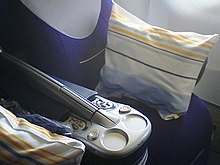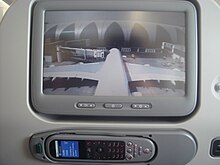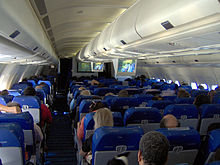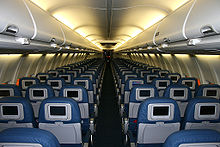Airline seat: Difference between revisions
No edit summary Tag: repeating characters |
Nucleusboy (talk | contribs) m Reverted 1 edit by 69.99.153.244 identified as vandalism to last revision by Plane Person. (TW) |
||
| Line 1: | Line 1: | ||
[[Image:Lufthansa Business.jpg|thumb|Business class seat in a Lufthansa [[Boeing 747]]-400]] |
[[Image:Lufthansa Business.jpg|thumb|Business class seat in a Lufthansa [[Boeing 747]]-400]] |
||
[[Image:Airbus onboard entertainment.JPG|thumb|upright|Control screen fixed to an economy class airline seat (Thai Airways International Airbus A340), the tray is stowed]] |
[[Image:Airbus onboard entertainment.JPG|thumb|upright|Control screen fixed to an economy class airline seat (Thai Airways International Airbus A340), the tray is stowed]] |
||
'''Airline seats''' are [[chair]]s on an [[airliner]] in which passengers are accommodated for the duration of the journey. Such seats are usually arranged in rows running across the airplane's [[fuselage]]. A diagram of such seats in an aircraft is called an [[aircraft seat map]]. |
'''Airline seats''' are [[chair]]s on an [[airliner]] in which passengers are accommodated for the duration of the journey. Such seats are usually arranged in rows running across the airplane's [[fuselage]]. A diagram of such seats in an aircraft is called an [[aircraft seat map]]. |
||
Revision as of 18:52, 27 July 2010


Airline seats are chairs on an airliner in which passengers are accommodated for the duration of the journey. Such seats are usually arranged in rows running across the airplane's fuselage. A diagram of such seats in an aircraft is called an aircraft seat map.
Features and amenities
On the oldest of planes, seats were armchairs which stood loosely in the cabin, but moving furniture in the aircraft is a safety hazard, and seats are now fastened to the floor. However, airlines usually want the flexibility to move seats around or remove them, so the seats are attached to rails underneath the floor which run along the aircraft fuselage. If the airline wants to reconfigure the seating, this is a minor operation.
For passenger safety, airline seats are equipped with seatbelts, and there is a "Fasten Seatbelts" sign above each seat which is lit up when passengers are expected to remain seated with the seatbelt fastened. This is during taxiing, take-off and landing, although turbulence may also prompt the captain to turn on this sign.
Basic amenities

Seats are frequently equipped with further amenities. Airline seats may be equipped with a reclining mechanism for increased passenger comfort, either reclining mechanically (usually in economy class and short-haul first and business class) or electrically (usually in long-haul first class and business class). Most aircraft also feature trays for eating and reading, either in the seatback which folds down to form a small table in most economy class seats, or inside the armrest which folds out in most first class, business class, bulkhead, and exit row seats. Most airline seats also feature a pocket which may contain an in-flight magazine and a "safety on board" manual.
On small and short-haul aircraft, or on low-cost carriers, some of these amenities may not be installed. For instance, on several aircraft Ryanair has installed non-reclining seats without seat pockets with the safety manuals stitched to the seat back instead.[1] Even on airliners with reclining seats, some seats may have a restricted recline or no recline. Typically this will be the rear row of the cabin where a rear bulkhead blocks the recline, or seats immediately in front of the emergency exit where a reclined seat might restrict access to the emergency exit, creating a potential safety hazard. Independent seat review sites such as SeatGuru often warn passengers against these seats. During take-off and landing the crew ask passengers to put their seats in an "upright" (unreclined) position[2] and to lift and stow their tray tables.
Advanced amenities

Electronics
Seats may be equipped with power ports (either EmPower, AC, or DC) for small electrical appliances and ports for headphones for the audio entertainment. Some airlines also place TV-screens in the back of each seat as part of the In-flight Entertainment system on long-haul aircraft.
Adjustable headrests
Most long-haul aircraft (and short-haul aircraft on some airlines) feature seats with adjustable headrests in all classes, allowing the passenger to adjust the headrest for comfort.
Adjustable lumbar support
Electrically adjustable lumbar support is found on most long-haul first class and business class seats. Rarely, economy class may also include a mechanically adjustable lumbar support on some long-haul aircraft, however, with the trend towards slimline seats in Economy class, this amenity has mostly vanished from most new Economy class seat installations. Examples of such aircraft with adjustable lumbar support in Economy class include Delta Air Lines' Boeing 777-200ERs and US Airways' A330-300s.
Massage
Some business class seats, such as the Recaro CL 4420, have a built-in massaging feature.
Lie flat/flat bed seating
Some business class cabins feature seats that recline to a sloped flat position. These "lie flat at an angle" seats allow for greater comfort than traditional recliner seats, but are less comfortable than fully horizontal flat bed seating.
Most international first-class and a growing number of international business-class cabins feature seats which recline to a full-horizontal flat position, forming a bed.
"Slimline" economy seating
Some airlines are now introducing new "slimline" seats in economy class. These seats, in addition to weighing less, allow airlines to increase capacity without significantly affecting passenger comfort. These type of seats were pioneered by Recaro, however, several other manufacturers (such as Weber Aircraft LLC) have introduced their own slimline seats as well. These seats may or may not feature moveable headrests, and generally do not feature adjustable lumbar support.
A newer innovation by Weber Aircraft LLC is a "high pivot point recline system", where the seat bottom moves forward in addition to the seat back tilting backwards[3]. Examples of such airlines that have introduced such seats to some of their aircraft include Delta Air Lines, American Airlines, and Avianca.
Seating layout


Airline cabins are frequently classified as narrow-body if there is a single aisle with seats on either side, or wide-body if there are two aisles with a block of seats between them in addition to the seats on the side.
The number of seats abreast is affected by the aircraft width. On very small aircraft such as the Beechcraft 1900 there are only individual seats on each side of the aisle (1x1 seating). The widest narrow body aircraft such as the Airbus A320 family and Boeing 737 aircraft have six abreast seating in a 3x3 layout. Asymmetrical layouts also exist, examples including the Embraer Regional Jet which have 1x2 seating while the Douglas DC-9 aircraft typically feature 2x3 seating.
On wide body-aircraft the center block of seats between the aisles can have as many as 5 seats on planes like the layout on some McDonnell Douglas DC-10 and Boeing 777 aircraft, although Boeing recommends the 3x3x3 over the 2x5x2 layout.[4] Very wide planes such as the Boeing 747 or the Airbus A380 have ten seats abreast, typically in a 3x4x3 layout, although this layout is also sometimes used as a high density layout on aircraft normally seating nine abreast, such as the 777 or DC-10.
Window seats are located at the sides of the aircraft, and usually next to a window, although some aircraft have seat rows where there is a window missing. Window seats are preferred by passengers who want to have a view, or a wall which they can lean against. Passengers in seats adjacent to the aisle have the advantage of being able to leave the seat without having to clamber over the other passengers, and having an aisle they can stretch their legs into. If a seat block has three or more seats, there will also be middle seats which are unpopular because the passenger is sandwiched between two other passengers without advantages of either window or aisle seats.[5] Middle seats are typically booked last.[6]
While there are some exceptions, most commercial aircraft seats are forward facing and on military aircraft seats are frequently rearward facing. Southwest Airlines previously offered a few rearward facings seats on some aircraft but that scheme has now ended. Rearward facing seats are also common on business jets, to provide a "conference" type layout. British Airways also has rearward-facing seats in its Club World (Intercontinental Business Class) Cabin. It has been argued that rearward facing seats are safer because in the event of a crash, the sudden deceleration will propel the passenger into a rearward facing seat instead of out of it meaning the force is distributed over the entire seat back, instead of the straps of the seat belt. The argument against such seats has been based on passenger comfort, safety and cost. It could be argued that passengers who desire the natural layout of forward facing seats may be uncomfortable with a rearward layout. On the safety aspect, the argument has been that during a plane crash, debris, such as luggage, will fly forward in the cabin, quite possibly into the passengers in rearward facing seats. On the cost aspect, rearward facing seats need additional strengthening which adds extra weight and therefore higher fuel costs.[7]
Many airlines provide maps of their seating configurations on the various aircraft they fly. SeatExpert.com and SeatGuru.com also show seat maps for a wide range of airlines and aircraft, along with descriptions of the best and worst seats on the aircraft.
Seat size
When evaluating the size (and comfort) of a seat, the main terms used are pitch and width.
Seat pitch
It is a common misunderstanding that "pitch" is the same as "legroom".
Seat pitch is an indication of legroom, referring to the space between a point on one seat and the same point on the seat in front of it. It is usually given in inches. For many carriers, the pitch in Economy class is 30 to 32 inches (76 to 81 cm). More seat pitch can mean more legroom, but it is also affected by the thickness of the seat back. Airlines have claimed that a reduction of seat pitch can be compensated for by a thinner seat-back design.[4]
The largest seat pitch in any commercial airline's short-haul economy section is 37 inches (94 cm) in Finnair's Airbus A319s.[8] American Airlines' business class seats in their Boeing 767-200s are 62 inches (160 cm), the largest in any short-haul business class.[9] US Airways' first class flatbed seats in their Airbus A330-300s have a seat pitch of 94 inches (240 cm).[10]
The seat pitch on low cost carriers can be as low as 28 inches (71 cm) in the case of Spirit Airlines but is typically either 29 inches (74 cm) or 30 inches (76 cm).[11]
Seat width
Seat width is the distance from armrest to armrest, in Economy class this is typically around 43 centimeters (17 in).[12]
Material
Airline seats are designed to be lightweight, but at the same time strong and fire resistant, while also taking into account passenger comfort. A typical design is an aluminium frame with blocks of urethane foam attached to it. A layer of fire-resistant fabric, for instance Kevlar, goes over this, and at the top is a layer of cloth or leather.[13]
Leather seats are more costly than traditional cloth seats. Even so, several airlines, including some low cost carriers, choose leather not only to present a more "luxurious" product, but also because such seats are easier to clean and prevent spilt liquids from soaking through to the padding.[14]
Color
In the fairly early days of aviation airline seats were typically of earthly and soft colours such as light browns and gray, intended to calm the passengers. During the 1970s brighter colours such as red and orange became more commonplace. After this shades of blue and gray, with a more business-like tone, have become the most common choice.[15] However, certain airlines such as Austrian Airlines, Emirates and Singapore Airlines still use soft colours on seats.
Auxiliary

Every individual seat (except for the very last ones at the rear of the cabin) has a small set of auxiliary controls built into the seatback for the passenger directly behind the seat. The seat itself normally contains a somewhat small flip-out, extendable tray (which must be locked into stowage during takeoff and landing), and, on newer aircraft, an LCD television screen directly above the tray. Directly above the seat (on the cabin ceiling) is a small console for the passenger's use. The controls on this console include:
- An air-conditioning nozzle that can be tilted, swivelled, and adjusted by the passenger to either induce or reduce the output. This feature is found on most narrowbody aircraft, however, many airlines have chosen to omit them on many newer widebody aircraft (such as the Boeing 777).
- A reading light (very similar in appearance to the nozzle) that can be turned on by the passenger for extra light, especially when the main cabin lights are turned off. The buttons to turn the lights on and off is usually located directly on the overhead console on most narrowbody aircraft, while on most widebody aircraft, the buttons are usually found together with the in-flight entertainment controls, generally located on the armrests, on seat backs, or through the touch screen interface on some personal televisions.
- A call button, that, when pressed, alerts an attendant on board to serve the passenger(s)in the row with the pressed button (the attendant is directed by a small light on the console and alerted by a quiet audio signal). As with the reading light buttons, the call button is usually located directly on the overhead console on most narrowbody aircraft, while they are found together with IFE controls on most widebody aircraft.
At window seats there are window shields for protection from sun light. They have to be slid up during landings and takeoffs by ICAO regulations and/or law. This rule is in place to provide visibility into the aircraft during emergencies. Some airlines also require passengers to keep the window shields down on long-haul flights for a certain period of time(with a corresponding decrease in cabin lighting), in order to allow passengers to sleep more easily. Many armrests provide devices for reclining the chair, control interfaces for in-flight entertainment systems and ashtrays — although smoking is prohibited on-board many aircraft by most airlines.
Manufacturers
Airline seat manufacturers include Acro Aircraft Seating of the United Kingdom [16], Recaro of Germany [17], EADS Sogerma [18] and Sicma Aero Seat [19] of France, Avio Interiors [20] of Italy, Contour Aircraft Premium Seating [21], Thompson Solutions {{James Thompson (researcher)]][22], and European Aviation of the United Kingdom, B/E Aerospace [23] and Weber Aircraft LLC [24] of the United States, Koito Industries Ltd [25] of Japan, Greiner PURtec [26] of Austria, DeCrane Aerospace [27] of the United States, Aero Seating Technologies[28] of the United States and ZIM Flugsitz GmbH of Germany [29].
References
- ^ Airline explores tolerance for frill-free flying CNN.com, February 26, 2004]
- ^ Upright position of Seat Backs FAA safety bulletin
- ^ Weber Aircraft LLC - Tourist Models
- ^ a b The Shrinking Airline Seat The Independent Traveller.com
- ^ Air Traveller's Handbook
- ^ Window Or Aisle? CBS News July 4, 2003
- ^ Flying backward, flying safer, Mail Tribune, J.T. Bushnell, August 2001
- ^ "Short-haul Economy Comparison Chart". SeatGuru. Retrieved 28 November 2009.
{{cite web}}: Italic or bold markup not allowed in:|publisher=(help) - ^ "Short-haul First/Business Class Comparison Chart". SeatGuru. Retrieved 28 November 2009.
{{cite web}}: Italic or bold markup not allowed in:|publisher=(help) - ^ "Long-haul First Class Comparison Chart". SeatGuru. Retrieved 28 November 2009.
{{cite web}}: Italic or bold markup not allowed in:|publisher=(help) - ^ "Spirit Airlines adds non-reclining seats to new planes". USA Today. Retrieved 22 April 2010.
{{cite web}}: Italic or bold markup not allowed in:|publisher=(help) - ^ The Chair St. Petersburg Times, July 21, 2003
- ^ Millennium Watch - fire-resistant airplane seat upholstery - Brief Article April, 2000
- ^ Blue Skies Time.com July 30, 2001
- ^ History of Airline Design Published on Airliners.net
- ^ http://www.acro.aero
- ^ http://www.recaro-as.com Recaro Aircraft Seating
- ^ http://www.sogerma.eads.net/ EADS Sogerma
- ^ http://www.sicma.zodiac.com/ Sicma Aero Seating
- ^ http://www.aviointeriors.it/ Avio Interiors
- ^ http://www.contour.aero/ Contour Aircraft Premium Seating
- ^ Thompson Solutions aircraft seat design eng and prototype
- ^ http://www.beaerospace.com/ B/E Aerospace
- ^ http://www.weberair.com/ Weber Aircraft LP
- ^ http://www.koito-ind.co.jp/english/flying/ Kotio Industries
- ^ http://www.purtec.at/eng/index.php Grenier PURtec Aircraft Seating
- ^ http://decraneaerospace.com/ DeCrane Aerospace
- ^ http://www.aeroseating.com/index.html Aero Seating Technologies
- ^ http://www.zim-flugsitz.de/en/home.php Zim Flugsitz GmbH
